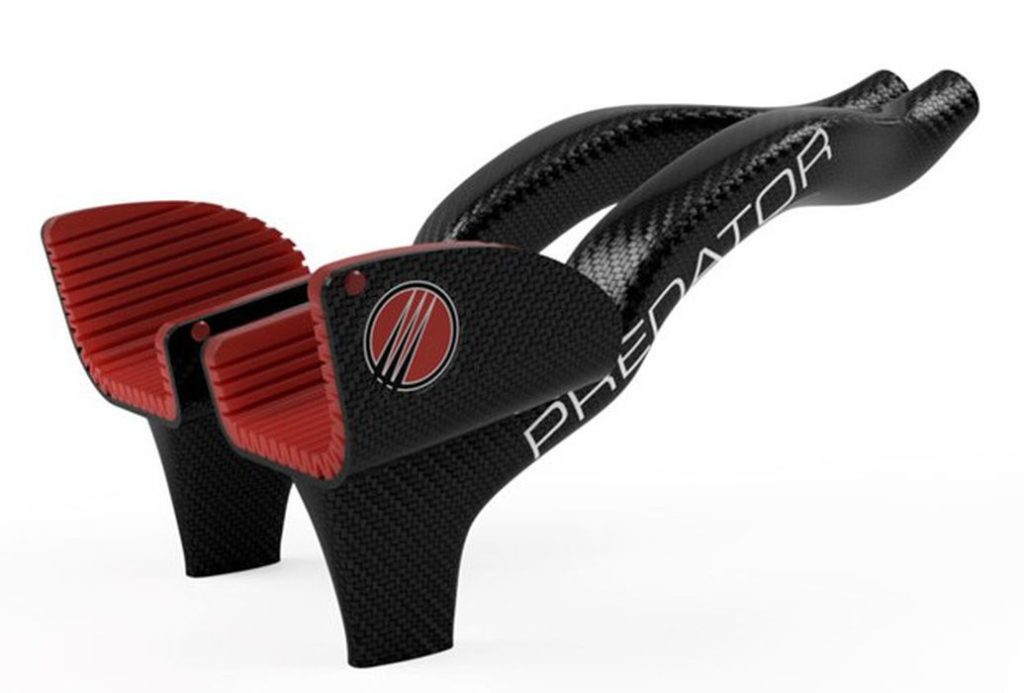
Predator Cycling introduces carbon fiber custom fitted bicycle bar extensions.
Predator Cycling has introduced a set of carbon fiber handlebars like no other. Light, strong and snugly fit to an individual rider’s dimensions, the custom-fitted, carbon fiber, sleek and sexy armrests will be the talk of the post-ride coffee shop stop—and as they are adopted by professional cyclists and, with a pinch of luck, first across the finish line in professional cycling time trials and triathlons.
In the sport of cycling, it is the time trial that holds the distinction of being the most grueling event. Imagine crouching forward and pedaling furiously, keeping your heart at the red line for two hours. The time trial may be called the “race against the clock,” but a better description would be a “fight against the wind.” The riders start off one after the other and are timed—as opposed to racing in a group to see who finishes first.
It is the air, not the clock or the terrain, that is the most formidable adversary in a time trial, and to fight through it and lessen its impact, the racer lowers their teardrop-shaped helmet into the wind so low that it is a strain for them to see ahead. From this awkward, bent-over position, the rider struggles to produce the power to fight through the air, which is getting disproportionally thicker the faster they go. Wind resistance increases as a square of the speed. For example, a pro cyclist racing at 30 mph (yes, they can do that) is going only 1.5 times faster than a recreational cyclist at 20 mph but encounters 2.2 times the wind resistance.
This is why the racer is crouched so low, back as flat as a table, arms out front, hands together as if praying to Aeolus, the Greek god of the Winds. The rider’s clothing is stretched over their body like a superhero so it doesn’t flap or catch the wind. In every way they can, they try to reduce the coefficient of drag, including the hardware underneath them. The bike’s wheels have elongated rim sections. Frame members are streamlined, too, and have thin brake and shift cables tucked inside them. The only permitted accessory, a water bottle, is streamlined or held in a streamlined cage.
Riding a bicycle is not natural and having to ride in a time trial position is even less so. You learned to ride a bike sitting upright. Now, to lower yourself and hold that position for two hours—the nominal time of a common Tour de France individual time trial—is torture.
For a professional cyclist, torture comes with the territory. And the stakes are high. A difference of a split second will determine where you stand on the podium, if at all. Prize money in top races, like the grand tours of Europe (Tour de France, Giro d’Italia and Vuelta a España), is in the millions of euros.

For a professional rider competing at the highest level, spending $1,795 for a streamlined bar setup will not sound like a bad idea. That’s the cost of Predator Cycling’s recently introduced Custom Aerobar Extensions.
Aero Bars (Not the Chocolate Kind)
Professional cycling, like any pro sport, has its rules in terms of what equipment and technology can be used to enhance performance. Some of these rules, such as how much a bike should weigh, are based on safety. Others are not as easily explained. Such as the rule for denying the “praying mantis” position for riders trying to break the one-hour record.
Unlike most time trial bar extensions that bolt onto the handlebars, Predator Cycling’s bars are custom fitted to the rider and fused onto Predator’s bar setup. The extensions provide better control, taking the slop out of steering with a snug fit made for each rider’s forearm. A time trial bike, more than a standard road bike, is designed to go straight. Turning all but the shallowest turn means taking your hands out of the praying, streamlined position and holding on to grips further from the center. From piercing the air to hugging the wind. There go split seconds off your time. With a rigid and forearm-hugging extension of the bar, the racer can leave their hands and arms in the optimum air-piercing position—and still make turns.
Read the rest at ENGINEERING.com
